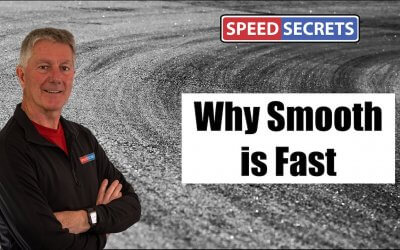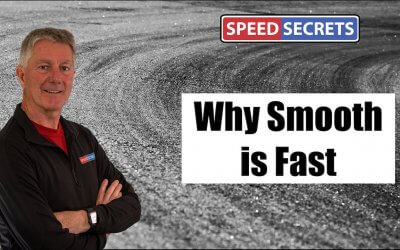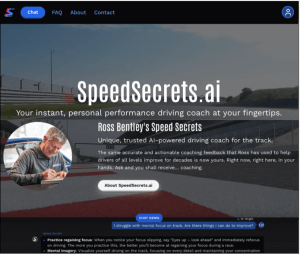Ask Ross
Q&A with Ross Bentley
Q: Should I trail brake to the apex of a corner, and then apply the throttle starting at the apex?
Q: “What is your opinion on the frequently expressed dictum “trail brake until apex then back on throttle starting at the apex”?”
Q: With a Front-Wheel-Drive car, should I rotate it early in the corner to reduce wheelspin on exit?
Q: “With FWD in a slow corner is some rotation a good way to solve inside wheelspin on exit?”
Q: Which corners should I use trail braking in, and which shouldn’t I?
Q: “Which kind of corner requires more or less trail braking? Or is that always car dependent?”
Q: How do I improve my driving abilities when I feel I’m pushing beyond them?
Q: “I feel like I am pushing beyond my driving limits for better laps times, so what are your recommendations for improving my driving abilities so I can keep progressing?”
Q: I’m faster when chasing another car – why and how can I be fast when not following another driver?
Q: “Why am I faster when I’m chasing another car in a race than I am by myself?”
Q: How do I improve my corner entry speed when driving on a racetrack?
Q: How do I improve my corner entry speed when driving on a racetrack?
Q: Should I always brake as late and hard as I can for every corner? Is there ever a reason for braking lighter?
Q: “If you started braking lighter at the same place entering a corner, wouldn’t that suggest that you’re not quite at the limit under braking? And wouldn’t that make you slower because you don’t have the car at the limit?”
Q: In endurance racing, when is it best to make it difficult for a faster car to pass, and when should our fastest driver be in the car?
Q: “I’ve read through your endurance racing eBook several times and it’s awesome. It’s a topic where there’s not a whole lot of information out there on. I have a couple of questions I was hoping I could pick your brain about. First, I completely agree it’s easier to let faster traffic by because you lose less time to the rest of your competitors. One question I have on that is sometimes we compete in rather small fields of around 20 cars for between 3-5 hours. We are not usually the fastest car based on lap time, but we do make up quite a bit of time based on pit strategy and time spent in the pits. Should we try to make it difficult on the faster cars to pass us? Not necessarily blocking anyone, but also not pointing them by. My second question is about when we should use our faster driver. We typically only use two drivers, with one being 3-5 seconds faster than the other one per lap. Do you want the faster driver to start the race and try to move up the pack as far as possible, or do you want the faster driver in when the pack is more spread out towards the end of the race? This one’s a bit of a head-scratcher for me. Any knowledge you have on these topics would be greatly appreciated.”
Q: What does “In a spin, both feet in” mean, and does it apply to PDK and semi-automatic cars?
Q: What does “In a spin, both feet in” mean, and does it apply to PDK and semi-automatic cars?
Q: What separates the champions from all other drivers? What tip would you give a driver to be a tenth of a second faster?
Q: “I’m ‘studying’ about the art of racing, mostly karting. What actually separates a champion from the rest of the field? You’ve said that what separates drivers is the release of the brakes. In karting, I see a lot of drivers brake in a straight line, turn in (with brake pedal) and move to the throttle. So, if I’m right, the best drivers brake in a straight line but at the turn in point they do not release the brake pedal but slowly release pressure on the brakes. How would a karting champion handle this transition? Racing is about fine-tuning your driving style, but what is perfect driving? You see drivers so close in lap-time, but what tip would you give someone to be a tenth faster than everybody else?”
Q: How do I reduce the amount of “chatter” I get with the tires while cornering?
Q: “I have a question for you – it’s about the ‘tire chatter’ I experience a fair amount of at Sebring. It’s most notable at Turn 7, and to a lesser extent at Turns 5 and 10. Other drivers have described this as me needing to reduce corner speed a bit, as well as not ‘throwing the car in there quite so aggressively,’ but I was wondering if you had other ideas. My setup is that I run a Ford Focus ST with some engine and suspension mods, and Maxxis Victra RC-1 tires. In experimenting on Turn 5 a bit I found that if I relaxed my hands a bit at the apex and let the car run out a bit more to track out, that I could reduce the amount of chatter, but the chatter is still there. I don’t see too much opportunity to do that sort of an adjustment at Turn 7.”
Q: How should I warm up my street tires when driving on a race track?
Q: “Can you comment on the differences between warming up street tires and brakes versus slicks (for track day guys using 200 treadwear tires & general knowledge)?”
Q: Why are new race track surfaces faster? Why do old tires have more grip?
Q: “Why are new track surfaces faster and why do they seem to like old tires? I race regularly at two north Texas tracks (Eagles Canyon and MSR Cresson), both of which have new surfaces. Cresson just received a new top coat and immediately became over a second faster. ECR is essentially a new track. Both tracks are at least a second faster on high heat cycle tires compared to stickers. What is it that makes newer surfaces faster, and why would old tires add to the speed even more?”
Q: Should I adjust brake bias during a race? How do I know when to adjust brake bias?
Q: “I am having trouble with brake bias adjustment. During a stint, are you supposed to advance the bias toward the front or toward the rear?”
Q: How hard should I be braking for a corner on a race track? What about trail braking?
Q: “In a chalktalk you did earlier this year there was a statement: get 2/3rds of the braking done in the first 1/3rd of the brake zone and the last 1/3rd in the last 2/3rds of the brake zone. I want to make sure that I got that right.”
Q: How should I prepare for my first track day?
Q: “How should I prepare for my first track day? It’s organized by a car club – I think they call it a HPDE event.”
Q: Do tires generate the same grip in braking and acceleration as they do in cornering?
Q: “Can you address the g-load differences between cornering and braking. Should tires be able to achieve equal lateral and longitudinal loading?”
Q: Is the turn-in point over-emphasized, and just how important is it?
Q: “I understand that a consistent turn-in is an important concept for novices, but I wonder if we spend too much time thinking about it as people progress through the spectrum. Just as we move from straight line braking to trail braking, should we be de-emphasizing turn-in as something to expect to be consistent? Or, am I missing something more fundamental?”
Q: Do different tires require different amounts of sliding to get the most out of them?
Q: “I wonder how much braking or braking transition points have to do with the changes in tires. I wonder if techniques have evolved with the tires? And does it vary with the type of car.”
Q: How do I know if I’m driving at my limit, or the limit of the car?
Q: “I seem to be pushing the limits NOT OF THE CAR, but my driving abilities lately as I try to improve my lap times. Where do I go from here to improve and not be frustrated with my driving? My lap times have improved with later, harder braking and carrying more speed through the corners.”
Got Questions?
Send your questions to Ross by email. Or, if you want an immediate answer, use SpeedSecrets.ai. It’s as if Ross is right there, coaching you.



